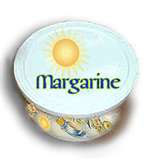Butter or Margarine?
By Patty Liston
 I am strictly a butter gal myself. There is nothing like warm bread with creamy butter melting on top of it. Margarine for me is a little more "iffy".
I am strictly a butter gal myself. There is nothing like warm bread with creamy butter melting on top of it. Margarine for me is a little more "iffy".
Napoleon III of France, nephew of Napoleon I, offered a prize for a butter spread that would be available for soldiers fighting on the front, as well as something to be used by the lower classes. Voila! The beginning form of margarine was invented.
 Of course over time this butter substitute crossed the ocean and came to the US where politics took over. The butter industry was against margarine, for obvious reasons, so margarine was given a higher tax. Then there was the issue of color. It seems that the butter lobby wanted margarine dyed a pink color to make it look unpalatable. Yellow was forbidden, although bootleggers sold yellow capsules that could be stirred into the margarine after purchasing. It all seems rather silly now, doesn't it?
Of course over time this butter substitute crossed the ocean and came to the US where politics took over. The butter industry was against margarine, for obvious reasons, so margarine was given a higher tax. Then there was the issue of color. It seems that the butter lobby wanted margarine dyed a pink color to make it look unpalatable. Yellow was forbidden, although bootleggers sold yellow capsules that could be stirred into the margarine after purchasing. It all seems rather silly now, doesn't it?
Everyone got a reality check during World War I and II when butter became a luxury item, and margarine consumption was at an all time high.
 Since then there have been several recipe changes and margarine and has evolved from some fairly unappealing animal-based ingredients (beef fat), into a vegetable-oil based spread with added chemicals that make it more flavorful and easier to spread. Like butter, margarine is about 80% fat, 20% water and solids, flavored, colored, and fortified with vitamin A, and sometimes D, to match butter. Health experts take issue with manufacturers hydrogenating vegetable oil, which creates unhealthy compounds that many doctors feel may contribute to heart disease and stroke. In addition, the heat and chemicals used to harden vegetable oils produce trans-fatty acids (TFAs), which can contribute to heart disease, increase cancer risks, promote inflammation and accelerate tissue degeneration.
Since then there have been several recipe changes and margarine and has evolved from some fairly unappealing animal-based ingredients (beef fat), into a vegetable-oil based spread with added chemicals that make it more flavorful and easier to spread. Like butter, margarine is about 80% fat, 20% water and solids, flavored, colored, and fortified with vitamin A, and sometimes D, to match butter. Health experts take issue with manufacturers hydrogenating vegetable oil, which creates unhealthy compounds that many doctors feel may contribute to heart disease and stroke. In addition, the heat and chemicals used to harden vegetable oils produce trans-fatty acids (TFAs), which can contribute to heart disease, increase cancer risks, promote inflammation and accelerate tissue degeneration.
Dr. Margaret Grogan of the Mayo Clinic suggests that "when selecting a spread be sure to check the Nutrition Facts panel and pay particular attention to the grams of saturated fat and trans fat. Look for products that have the lowest combined amount. Also, look for products with a low percent Daily Value for cholesterol.
"If you don't like the taste of margarine or don't want to give up butter completely, consider using whipped or light butter. Or look for products that are a blend of butter and olive or canola oil. Per serving, these products have less fat and calories than regular butter does. The important thing is to use them sparingly."
 Between the two, butter is the better choice because it is closer to a whole food. Remember that any listed ingredient not easily found in nature is going to be further down the "good for your health" spectrum. If you want to try something different and even healthier, skip the butter and the margarine from time-to-time and spread a little extra virgin olive oil on your toast instead.
Between the two, butter is the better choice because it is closer to a whole food. Remember that any listed ingredient not easily found in nature is going to be further down the "good for your health" spectrum. If you want to try something different and even healthier, skip the butter and the margarine from time-to-time and spread a little extra virgin olive oil on your toast instead.

